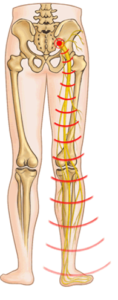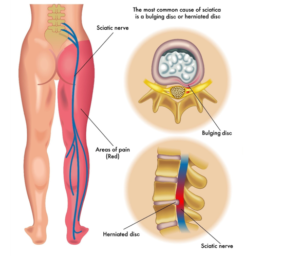
Do you know not all back pain is Sciatica?
Sciatica is the compression of the largest nerve in the body ,the sciatic nerve. Sciatic nerve begins from the lower lumber and travels down in the legs either one side or both side and it mostly occurs in between the age of 18 to 40 years.
Irritation of the sciatic nerve can cause lower back pain which radiates in the lower limb including weakness. Numbness or sometimes tingling sensation.
Sciatic nerve pain:-
Often characterized by one or more of the following symptoms
- Constant, shooting pain radiating in buttocks, posterior thigh and down in the leg and foot unilaterally or bilaterally.
- Pain intensity increased in sitting position.
- Patients always complains of weakness and some times numbness and tingling sensation in the affected leg.
- Sharp , burning pain which make it difficult to stand up and walks

Causes of sciaticaUsually sciatica is caused by :
- Bulging , prolapsed, herniated or a ruptured disc which compresses the sciatic nerve.
- Degenerative disc disease due to normal aging process.
- Improper technique for lifting heavy weights.
- Physical trauma.
- Sudden twist or jerky movements.
- Spinal misalignment.
- Any pathology.
- Tight piriformis muscle.

Physiotherapy treatment
Physiotherapy plays an important role in sciatica treatment and a physiotherapist can design a treatment protocol in combination of thermotherapy, electrotherapy, spinal manipulation and myofascial release according to the severity of the pain. Physiotherapist is very well trained who can advice you about your posture and can look for any muscle imbalances in the body.
Physiotherapy treatment for sciatica divided in to parts.

Pain management
Thermotherapy- hot and cold pack to reduce inflammation and muscle spasm.
Electrotherapy-TENS and IFT using a modified current to stimulate the peripheral nerves and sensory nerve ending. The stimulation caused by electrotherapy helps brain to release more endorphins to over ride the sciatic pain
Ultrasound- sound waves with thermal effects that penetrates deep into the tissue to increase circulation and to promote healing process.
Spinal manipulation-spinal manipulation corrects ant misalignment the spinal Colum producing pain.
MFR-myofascial release specialized manual technique to correct the muscle imbalances
Strengthening program-specialized exercise protocol design by your therapist including stretching exercise and strengthening exercise will help you recover faster and prevent you for further problems.
Prevention
Walking- slow walking is important to exchange the nutrition for the disc and to avoid muscle weakness.
Posture- improve your posture don’t sit regularly more than 20 to 30 minutes take break and tretch your body.
Weight lifting- while lifting heavy weight always bend your hip and knee and hold the object close to your body.
Water intake-increase water intake to hydrate the disc and for batter drainage.
Sleeping- use firm mattress and thin pillow to maintain the spinal curves.